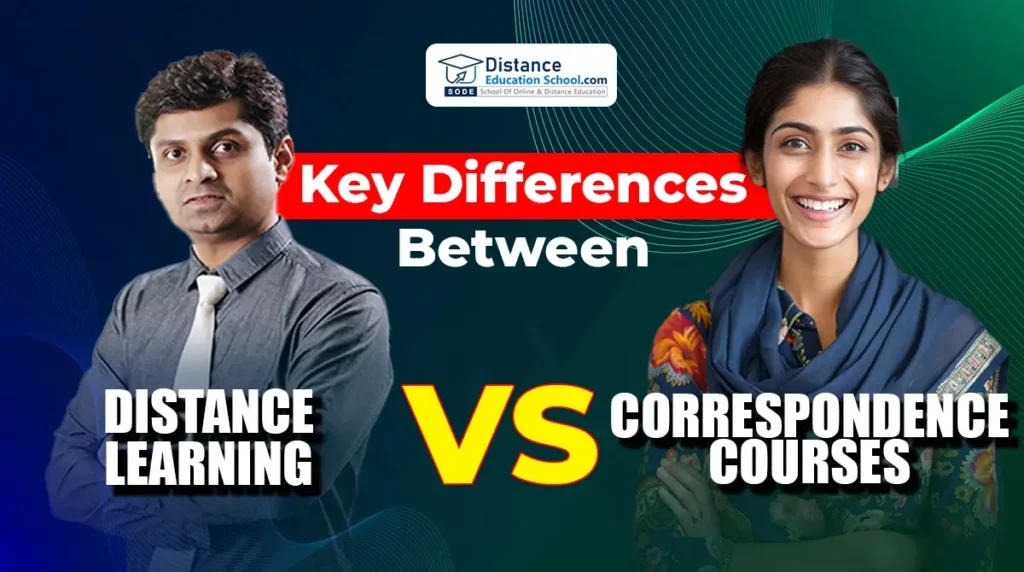
Difference Between Distance Learning vs Correspondence Courses
Today, many students prefer to study from home instead of going to a regular college. This has made flexible learning options like distance learning and correspondence courses very popular. While both methods allow you to learn remotely, they are not exactly the same. Many people get confused between the two. That’s why it is important to understand the key differences before choosing the right one for your education.
In this blog, we will explain about distance Learning vs correspondence courses,what each method means, how they work, and which one might be better for you.
What is Distance Learning
Distance learning is a modern method of education where students and teachers are not physically present in the same classroom. Instead of going to a college or school building, students attend classes using the internet and digital devices like laptops, mobiles or laptops. It is ideal for students who want to study while working, live in remote areas, or prefer flexible learning schedules. This type of learning has become very popular in recent years, especially after the rise of online education platforms and UGC approved online degree programs.
| Key Feature | Description |
|---|---|
| Live or Recorded Classes | Students attend classes online through live video sessions or watch recorded lectures at their convenience. |
| Digital Study Materials | Notes, textbooks, video tutorials, and practice tests are shared through apps or email in formats like PDF, PPT, or video. |
| Interactive Learning | Students can ask questions, join discussions, and even get personal doubt-solving support from teachers. |
| Online Exams & Assignments | Most assessments, quizzes, and exams are conducted online. Assignments are submitted through learning portals. |
| Mentorship & Support | Students receive regular updates, reminders, academic support and sometimes even placement assistance. |
| Flexibility | You can learn from anywhere and manage your time according to schedule. |
Example
If you join an Online MBA course from Amity University Online, you will:
- Attend live classes from your laptop.
- Download notes and videos through the university’s portal.
- Submit assignments online.
- Give exams from home or at a designated online test center.
- Interact with faculty members and peers through discussion boards or chat.
What are Correspondence Courses
Correspondence courses are one of the oldest and most traditional forms of remote learning. These courses are conducted without any online tools or live classes. All communication between the student and the university happens through post, courier or sometimes email.
This method is best for students who may not have access to the internet or digital devices. It is also suitable for people who prefer reading from printed books and studying independently without regular interaction.
| Key Feature | Description |
|---|---|
| Printed Study Materials | Universities send physical books, notes, and assignments to the student’s postal address. |
| No Online Classes | There are no video lectures or live teaching sessions. Students must study the material on their own. |
| Self-Paced Learning | Students can decide their own study hours without any fixed class schedule. |
| Minimal Communication | There is little or no regular interaction with teachers. Queries are usually solved via post or in-person during exam visits. |
| Offline Exams | Students need to visit the university’s assigned exam centers to write their exams. |
| Low-Cost Option | Fees for correspondence courses are usually lower than distance or online learning. |
Example
If you enroll in a BA Correspondence course from Madurai Kamaraj University, you will:
- Receive textbooks and printed notes by post or courier.
- Study the subjects on your own without any video lectures.
- Prepare for exams independently.
- Visit a nearby exam center at the end of the term to give your written tests.
This mode is good for students who live in rural areas or want an affordable, simple way to get a degree without attending regular classes.
Key Differences Between Distance Learning and Correspondence Courses
Understanding the difference between distance learning and correspondence courses can help you choose the right path for your education. While both offer flexibility, the way they are conducted is quite different. Let’s look at the key differences between the two learning methods.
| Feature | Distance Learning | Correspondence Courses |
|---|---|---|
| Mode of Study | Online (videos, live classes, apps) | Offline (books sent by post) |
| Student Interaction | Yes (through chat, email, video calls) | Very limited or none |
| Technology Use | High (uses internet, apps, e-portals) | Very low (mainly books) |
| Assignment Submission | Online | Offline or sometimes through post/email |
| Exam Format | Online or at test centers | Mostly offline at exam centers |
| Learning Experience | Interactive and updated | Self-paced, more independent |
Advantages of Distance Learning
Distance learning offers many benefits for modern students who want flexibility without giving up on quality education.
| Feature | Description |
|---|---|
| Interactive Learning | Students can attend live online classes or watch recorded video lessons. Many platforms also offer doubt-clearing sessions, quizzes, and interactive assignments that keep learning engaging. |
| Flexible and Convenient | You can study anytime, from anywhere — whether at home, while traveling, or after work. All you need is a mobile or laptop with internet. This makes it easier to balance studies with job or family responsibilities. |
| Up-to-date Resources | Online programs provide access to digital libraries, e-books, lecture slides, and updated content. This ensures you’re learning the latest topics that match today’s industry needs. |
| Regular Support | Many universities assign mentors or faculty coordinators who guide students throughout the course. You can ask questions through emails, discussion forums, or video calls. |
| Career-Friendly | Distance learning is perfect for working professionals who want to upgrade their skills or earn a higher degree. Some programs also offer placement support, resume help, and career counseling. |
| Saves Time and Travel Cost | You don’t have to travel to campus or spend time commuting. Everything is accessible from your screen, saving both time and money. |
Advantages of Correspondence Courses
| Feature | Description |
|---|---|
| Low Fees | These programs are very affordable, making them a great option for students with limited budgets. The cost is usually lower than distance or regular courses. |
| Ideal for Low-Tech Areas | If you live in a place with no or slow internet or don’t have access to computers, correspondence learning is a practical choice since study materials are sent by post. |
| Self-Paced Study | There are no fixed class schedules. You can study whenever you want and go through the material at your own speed. This is useful for people who work or have other commitments. |
| Suits Independent Learners | If you are good at self-study and don’t need much teacher support, correspondence courses allow you to study quietly and focus without distractions. |
| Simple Process | The course format is easy to follow — read the material, prepare for exams, and appear for offline tests at the exam center. |
Top Distance Universities in India
India has several well-known universities that offer quality distance education programs. These universities are approved by UGC and provide flexible learning options for students across the country. Here are some of the best universities in India for distance courses:-
IGNOU
LPU Distance university
Delhi University School of Open Learning
Mumbai University
Karnataka State Open University
Annamalai Distance Education
Tamil Nadu Open University
Dr. B.R. Ambedkar Open University
Osmania University Distance Education
Acharya Nagarjuna University
Alternatives of Distance Learning in India
Online learning is one of the most popular and modern alternatives to traditional distance education. It allows students to study from anywhere using a mobile, laptop, or tablet with internet access. Unlike old-style distance education, online learning is more interactive, engaging, and updated with the latest technology
| Key Feature | Description |
|---|---|
| Live and Recorded Classes | Attend real-time lectures or watch recorded videos at your convenience. |
| Digital Study Material | Access e-books, notes, presentations, and quizzes on learning platforms. |
| Online Assignments and Exams | Submit your work and take tests through online portals. |
| Regular Support | Stay connected with teachers and mentors via chat, email, or video calls. |
| Flexibility | Study from home at your own pace, while balancing work or other responsibilities. |
Popular Universities Offering Online Learning
- Amity University Online
- Jain University Online
- Chandigarh University Online
- Manipal University Online
- Lovely Professional University (LPU) Online
Online learning is ideal for working professionals, stay-at-home parents, and students who want quality education without attending a physical classroom. It’s recognized by UGC and offers full-time degrees that are equivalent to regular degrees.
Final Thoughts
Both distance learning and correspondence courses help students learn from home. The difference lies in how the learning happens – one uses digital tools, while the other depends on printed material. If you’re comfortable with using the internet, attending online classes, and submitting assignments digitally, distance learning is a better option. But if you prefer a simple, low-tech method with printed books and self-study, then correspondence courses might be right for you.
Always check the university’s approval (UGC/AICTE) and course details before applying. Choose the one that fits your lifestyle, budget, and learning needs.
Most Popular Blogs

Top Distance/Online MBA Universities in Jaipur 2026

Is the Amity Online Degree Valid?

Top Distance MBA Universities/ Colleges in Ahmedabad 2026

List of Tamil Nadu Open University Certificate Courses: Fees and Admission 2025

Top Distance MBA Universities/Colleges in Surat 2026



















